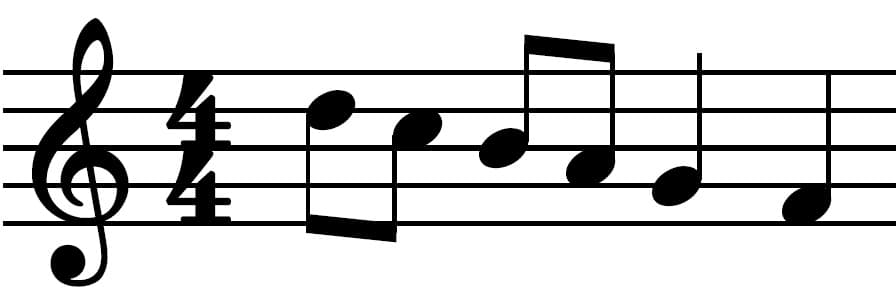Myths about teaching can hold you back
- Year 11
- Eduqas
Identifying melodic shape
I can identify the shape of a melody and represent it visually.
- Year 11
- Eduqas
Identifying melodic shape
I can identify the shape of a melody and represent it visually.
These resources will be removed by end of Summer Term 2025.
Switch to our new teaching resources now - designed by teachers and leading subject experts, and tested in classrooms.
These resources were created for remote use during the pandemic and are not designed for classroom teaching.
Lesson details
Key learning points
- Identifying the shape of a melody is key to melodic dictation.
- The melodic shape has to account for ascending and descending pitch, as well as conjunct and disjunct movement.
- With disjunct intervals, we have to listen carefully to notice whether they are large or small leaps.
- We can represent melodic shape using a line.
- We can then approximate the correct pitches by drawing notes in to fit the rough melodic shape.
Keywords
Melodic dictation - the process of listening to a melody and writing it down
Melodic shape - the shape of a melody, including how it ascends and descends and where it is conjunct or disjunct
Conjunct - a melody (or part of a melody) that moves by small intervals (semitones or tones)
Disjunct - a melody (or part of a melody) that moves by intervals larger than a tone
Common misconception
Only advanced musicians can work out a set of notes by listening to them.
Anyone can work out notes by ear, if they practise the correct strategies. Identifying the melodic shape, representing it with a line, then carefully converting it into notes is an effective first step in melodic dictation.
To help you plan your year 11 music lesson on: Identifying melodic shape, download all teaching resources for free and adapt to suit your pupils' needs...
To help you plan your year 11 music lesson on: Identifying melodic shape, download all teaching resources for free and adapt to suit your pupils' needs.
The starter quiz will activate and check your pupils' prior knowledge, with versions available both with and without answers in PDF format.
We use learning cycles to break down learning into key concepts or ideas linked to the learning outcome. Each learning cycle features explanations with checks for understanding and practice tasks with feedback. All of this is found in our slide decks, ready for you to download and edit. The practice tasks are also available as printable worksheets and some lessons have additional materials with extra material you might need for teaching the lesson.
The assessment exit quiz will test your pupils' understanding of the key learning points.
Our video is a tool for planning, showing how other teachers might teach the lesson, offering helpful tips, modelled explanations and inspiration for your own delivery in the classroom. Plus, you can set it as homework or revision for pupils and keep their learning on track by sharing an online pupil version of this lesson.
Explore more key stage 4 music lessons from the Listening: dictation unit, dive into the full secondary music curriculum, or learn more about lesson planning.

Equipment
Licence
Prior knowledge starter quiz
6 Questions
Q1.If a melody moves by small steps, we call it .
Q2.If a melody moves by leap, we call it .
Q3.How many semitones are in a tone?
Q4.If a melody rises in pitch, we would say it is .
Q5.If a melody falls in pitch, we would say it is .
Q6.Tick two words that accurately describe this melody.

Assessment exit quiz
6 Questions
Q1.Which two words accurately describe this melody?

Q2.What is the largest possible interval in a conjunct melody?
Q3.What is the smallest possible interval in a disjunct melody?
Q4.Which sentence best describes this melody?

Q5.Which sentence best describes this melody?




